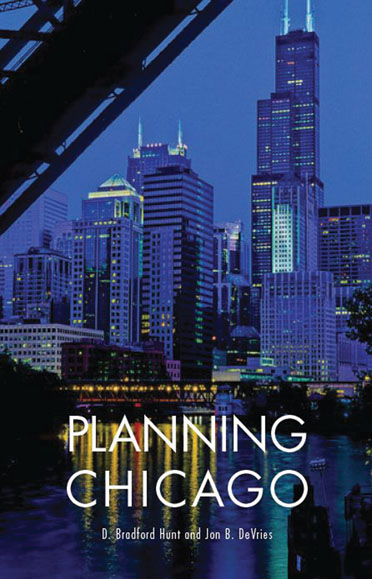
In Chicago, the word “planning” often evokes the image of Daniel Burnham and his 1909 “Plan of Chicago.” In his famous plan, Burnham proposed superhighways and lakefront parks and, while it was never implemented wholesale, its cohesive vision regarding the downtown and lakefront areas helped put Chicago on track to become a modern city. But “Planning Chicago,” a historical take on Chicago’s urban transformation published last February, argues that the stronger push for Chicago’s modern development came long after Burnham. The Chicago we know, the book claims, was developed not with one big plan but with many small skirmishes and a few big oversights.
In their book, authors D. Bradford Hunt and Jon DeVries, both of Roosevelt University make the claim that city planning by city officials, or a lack thereof, is responsible for Chicago’s current economic and social condition. But what exactly is city planning? Planning can involve anything from transportation infrastructure to the construction of upscale housing developments, from public parks to rail yards. In short, it involves making decisions about what to do in order to make a city, and make a city better. And as the authors argue, it is something that the city of Chicago has neglected since Burnham’s “Plan” was released.
The best chapters of the book are those that examine three very different neighborhoods: Little Village, Englewood, and Uptown. Taken as a whole, the chapters demonstrate how planning can make or break a neighborhood. In Englewood, for example, poor planning turned a formerly thriving commercial area into an impoverished neighborhood with few spaces for community members to gather. Hunt and DeVries argue that the city attempted to develop commercial spaces and Kennedy-King Community College without forming a cohesive long-term plan for the neighborhood, letting vacant lots and foreclosed homes multiply in Englewood. The Englewood Quality of Life Plan, however, developed in 2005, offers a complete vision for commercial and residential redevelopment but has, unfortunately, been stymied by a lack of funding.
The book nicely handles Chicago’s journey from a “rust belt metropolis” to a modern world city. Though the chapters on the history of the city’s industrial policies are not exactly exciting, they help readers understand the importance of Chicago’s railroads and factories. Particularly important was the redevelopment the city did in the Lake Calumet industrial district. The expansion of the Calumet industrial park played an instrumental role in attracting Ford Motors, which was looking for a city to build a huge supply plant. Ford decided on Chicago because of skillful real estate planning and development in Calumet, and their supplier park has been an economic boon for the city. After covering industrial Chicago, the authors move on to postindustrial Chicago, discussing the history behind tourist destinations such as Navy Pier and Millennium Park, two of the city’s most popular attractions. Particularly memorable is the chapter about the political battles over Navy Pier.
It is a shame that the book’s first section, which tells the story of the Loop’s growth over the twentieth century, is not nearly as interesting. It focuses far too much on the politicking between different planning organizations within the city government. Very rarely in this section do Hunt and DeVries actually discuss what was built in the Loop over the years. At the end of the book, however, in discussing twenty-first century planning, the authors reveal interesting details about the forthcoming six-block extension of the Chicago Riverwalk and Northerly Island, which is slated for a massive redesign under local architect Jeanne Gang.
Hunt and DeVries conclude by arguing that Chicago should return to the days of Burnham’s “grand plans” instead of neglecting long-term, cohesive city planning. This is hardly surprising, considering who they are and who their publisher is (the press division of the American Planning Association, which represents city planners from across the country), but by the end of the book they have shown that city planning has significantly influenced the course of Chicago’s development.
The only thing that makes the thesis in “Planning Chicago” hard to swallow is the fact that it is simply not an engaging book. It features extensive sections of trivial information about which organization wanted to plan what, why they wanted to plan it, why they couldn’t plan it, and so on. It is understandable for a book written by planners to in some sense be for planners, but such dirges of seemingly inconsequential history sometimes make reading the book like searching for diamonds in the rough. Still, even though there might be more interesting books about Chicago out there, “Planning Chicago” provides a well-researched look into a neglected side of our city’s history.
“Planning Chicago,” by D. Bradford Hunt and Jon B. DeVries. APA Planners Press. 336 pages.
